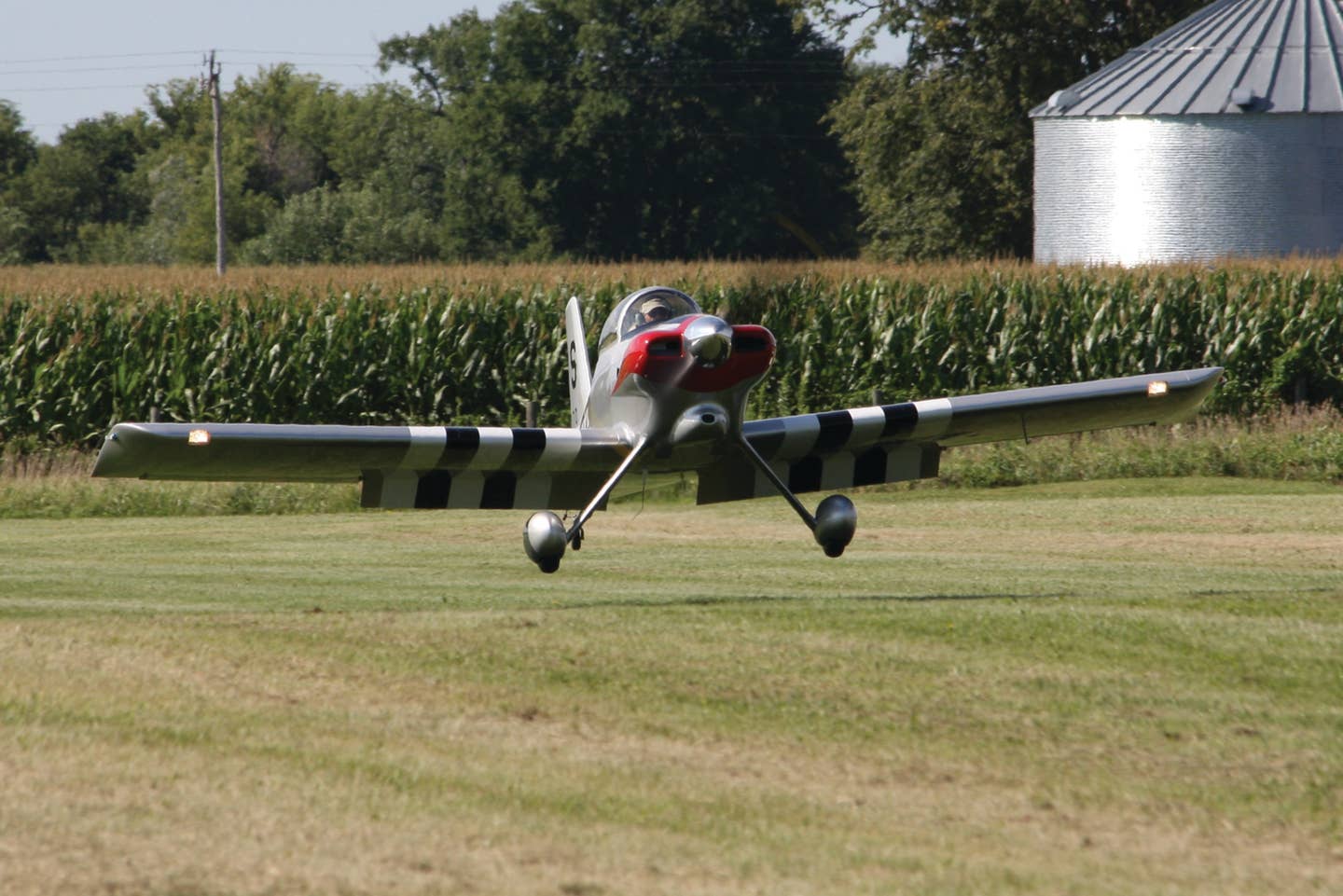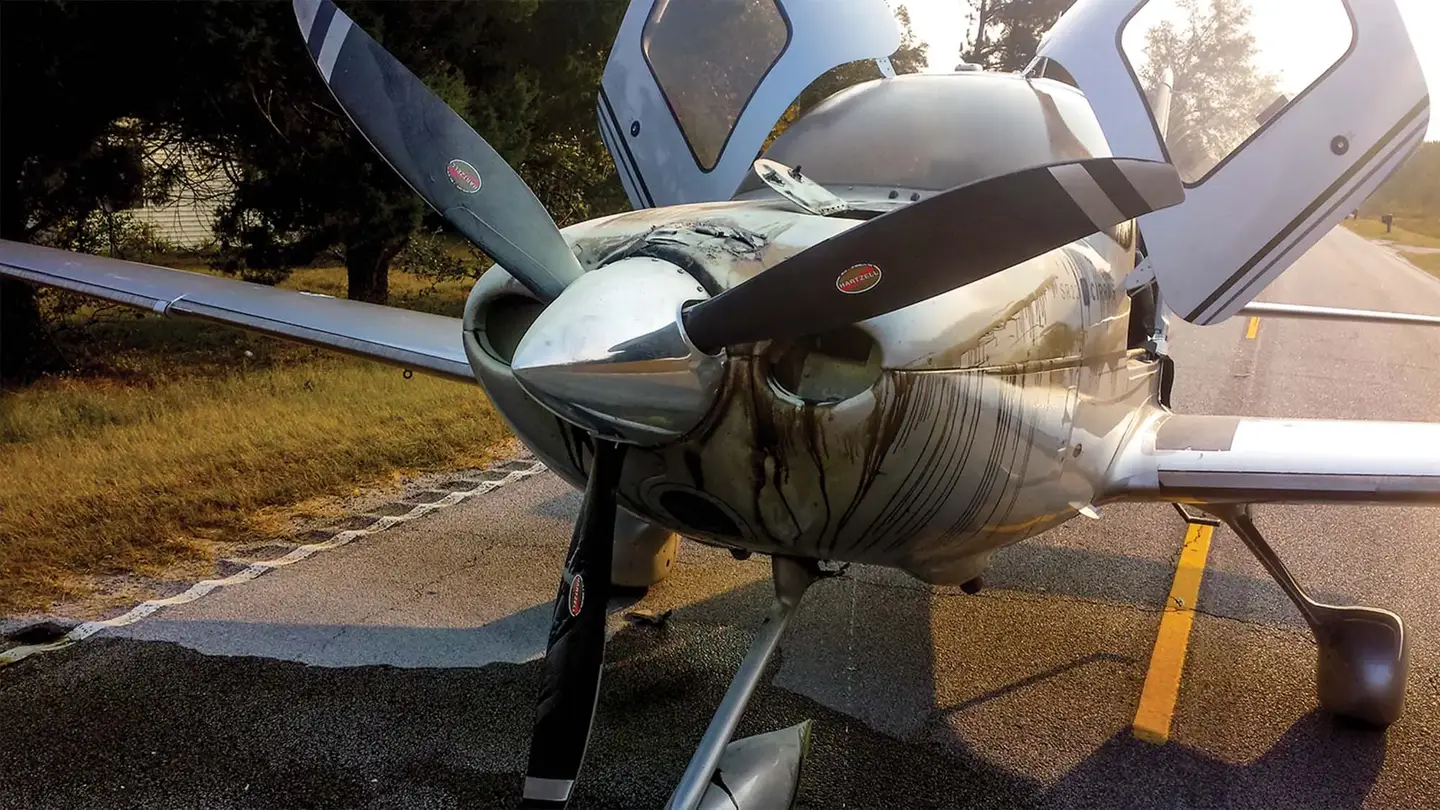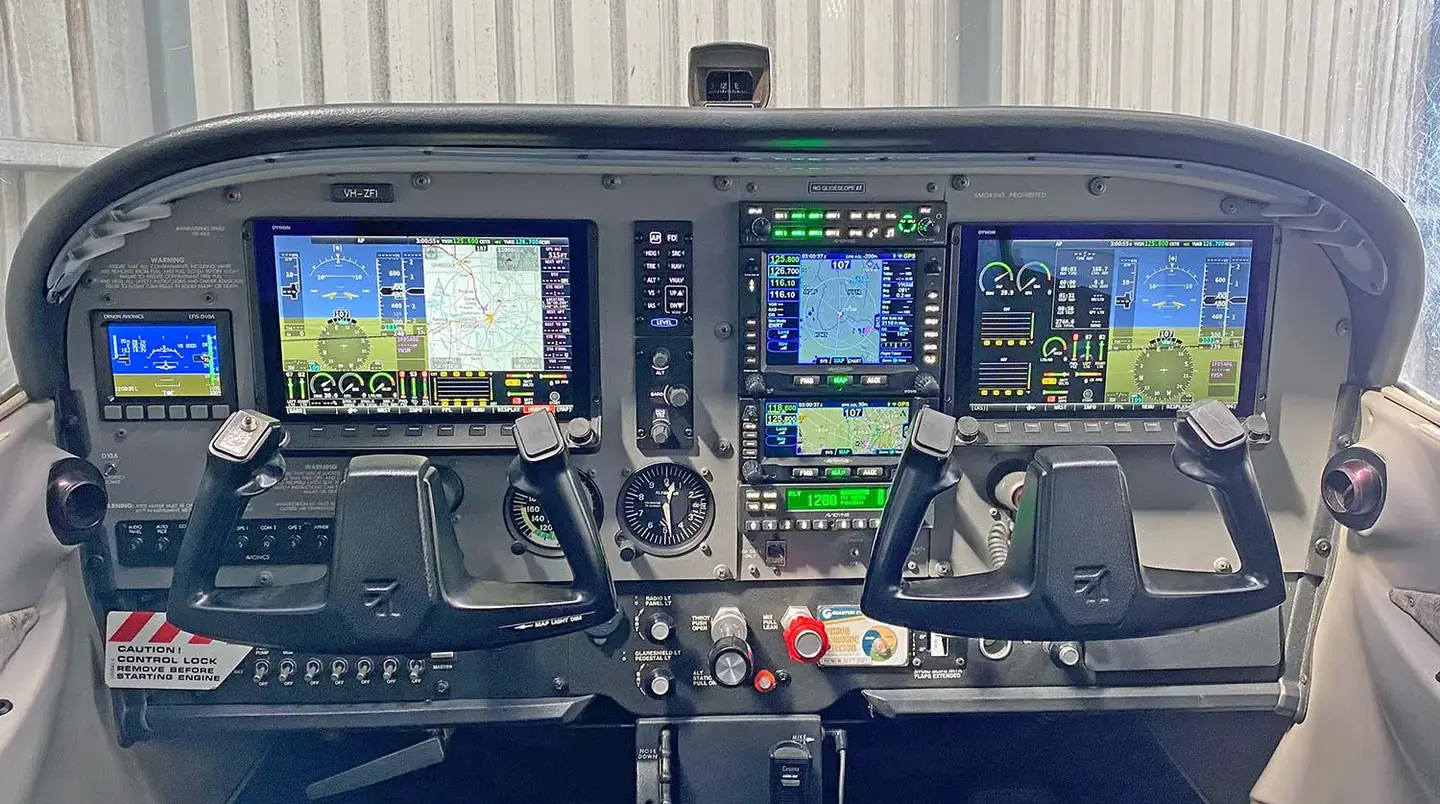When The Bottom Drops Out
I had to fly a go-around the other day. My instructor and I were landing in my Debonair at a familiar airport on a gusty day after 1.5 hours of…

Image: D. Miller
I had to fly a go-around the other day. My instructor and I were landing in my Debonair at a familiar airport on a gusty day after 1.5 hours of instrument work. Although I was accustomed to the airport and the visual approach, I had forgotten how windy conditions at this particular runway could wreak havoc with my plans, thanks to the nearby trees and structures on the surface disrupting the stiff breeze.
The plane was configured for landing with full flaps, a rich-enough mixture and the prop set for high RPM. I was decelerating from crossing “the fence” at 70 KIAS. As I pulled off some of the remaining power and began to flare, the bottom fell out about 25 feet above the runway. I already had established a nose-up attitude for the tricycle-gear airplane’s touchdown, but our descent rate suddenly increased sharply as the gusty crosswind basically disappeared at the wrong time. To compensate, I pulled back on the yoke even more, increasing our pitch attitude in the hope doing so would compensate for the sudden loss of altitude and I could salvage a smooth touchdown. But it was not to be. For the first time in a long time, I really bounced the landing. Both main struts contacted the paved runway at the same time, compressed and then extended, pushing us back in the air. There we were, maybe six or eight feet in above the runway, with idle power and decaying airspeed. What to do?
Salvageable
The situation presented me with three possible reactions. One, I could do nothing except maintain the airplane’s attitude—perhaps increasing the nose-up attitude even more—and let the airplane settle back to the runway. Even though the stall warning didn’t go off throughout this botched touchdown, I didn’t want to subject the landing gear or the airplane to another touchdown of that magnitude.
The second choice was to add enough power to arrest the descent, then reestablish the flare attitude and slowly retard the throttle for a smooth touchdown. The only real trick with choosing this option was that it requires some remaining runway. During the approach, I had been aiming for a touchdown about 350 feet beyond the 3200-foot-long runway’s threshold. Hovering there momentarily over the centerline, even a pessimistic estimate of runway remaining would have been 2500 feet, more than enough to salvage this landing.
Initially, I chose Door Number Two. But as I added power to arrest the descent, I asked myself why I was trying to salvage it and, in that split second, I was reminded about how badly other pilots’ attempts to recover from a bounced landing have gone. (Reading accident reports for a living will do that to you.) My initial intent was to add partial power; just enough to regain control of the airplane’s vertical trajectory and then complete the landing. But as I did so, I decided to cut my losses and just go around. I smoothly and incrementally added full power, let the airplane accelerate and climbed away.
Bad Landings
We all make bad landings from time to time, which we can define as things not working out as we planned. Really bad landings, of course, involve damage, but any landing after which you can still use the airplane doesn’t meet the test, according to the old saying. Another old saying—about good landings—is that they usually occur after a good approach. That’s generally true. But a bad landing doesn’t automatically mean the approach was similarly faulty. And good landings can be extracted from poor approaches.
In this case, the approach was merely okay. I was on-speed and on-glidepath for the landing, but I had been momentarily distracted by an airplane taxiing for takeoff. We had flown over that airplane on short-short final, as it was occupying a portion of the runway’s displaced threshold/overrun. (We were in contact via the CTAF and each of us knew what to expect.) That was unusual for me, and I may have let it grab too many of my CPU cycles during the approach. Still, there wasn’t anything wrong with the approach, and all would have been well without the last-second change in the wind.
Yeah, I blame the wind. So did the instructor riding shotgun with me, who noted as we climbed out that the wind can be squirrelly when landing on that runway. The thing is, I knew that, having landed there many times before, but had simply forgotten. While the changing winds right above the runway didn’t help, the whole thing still was my fault: I was the one doing the flying.
I did two things wrong. First was not recognizing the potential disruption posed by trees and structures near the runway’s end. Even if I had never flown in there before, the local conditions—maybe a 10-knot breeze of variable direction—along with the obstructions upwind from the touchdown zone should have clued me in to what was about to happen.
The second thing I did wrong was plan on touching down in the first few hundred feet of the runway, which was silly. I had 3200 feet in front of me and know I wouldn’t need even half that to touchdown and stop. I easily could have—and should have—aimed to touch down farther along the runway. I wanted to taxi off to the left at the end, anyway—may as well fly part of the way.
Spring-Loaded For The Go?
This magazine and other resources generally will recommend something to the effect of “pilots should be spring-loaded to go around whenever we feel like things aren’t working out.” We also point out that once the decision to go around is made, that’s it. You go around. You don’t get a second bite at the apple. But what does any of that really mean?
When we talk about being “spring-loaded,” we mean you should be ready to get out of Dodge. The airplane should be configured for application of full power and the plan for what you’ll do next, which I’ll get to in a moment, should have been formulated before turning base. We also talk about how we don’t have to land out of this approach, no matter how good it is. If another airplane pulls out to take off, a vehicle or animal strays onto the runway, the wind messes up your flare or for myriad other reasons, we should be able to smoothly and automatically transition both ourselves and the airplane into go-around mode. In other words, we should have a plan, triggered by whatever condition or conditions in your view merit aborting the planned landing and going around for another try.
The decision to go around from a visual approach can be made at any time, including when already on the runway, if sufficient distance remains. Earlier is better, but there are two key things here. One is avoiding indecision. The other is having done this before.
Indecision can mean an on-again, off-again method for dealing with the need to go around. Bad idea, since in extreme cases we’ll be bouncing down the runway, torn between trying to salvage the landing or abandoning the effort and going around. (Think of indecision in this instance as Schroedinger’s Go-Around, after the physicist’s hypothetical designed to point out a flaw in quantum theory.) The punchline? Once you decide to go around, there’s no turning back.
Finally, of course, it helps to have done a go-around before, whether in training or for real. My primary training included endless trips around the traffic pattern, many of them culminating in an approach to landing during which, within a couple hundred feet of the ground, the instructor would make and announce the decision to do a full-stop landing, a touch-and-go or a go around. Whatever he or she decided—for whatever reason—I executed. It was a variation on the “Simon Says” game, perverted for the instructor’s evil and sadistic purposes. That said, it’s served me well over the years.
Now What?
So you’ve successfully corrected for the bounce—or dodged the deer on the centerline—and are climbing away from the runway with full power. Per the manufacturer’s recommendations, retract the wing flaps, re-trim for the appropriate climb speed and ensure the airplane is properly configured. (Don’t forget to open the cowl flaps, if any, and announce your intentions on the CTAF or to ATC.) What are your intentions?
In most cases, we’ll want to fly the same VFR traffic pattern we just completed. In extreme cases— there’s just too much crosswind, for example—you’ll want to come up with a Plan B. That can be a different runway or a different airport. Regardless, even if you stay in the pattern, you’ll have a moment or two to consider what, if anything, you did wrong and why you went around. The idea is to fix the problem, if any, on the next approach and landing.
In my example, we went around, left the landing gear extended, and landed safely and smoothly on the next attempt. The only thing I did differently the second time was to aim further down the runway to avoid the worst of the wind’s effects, which I should have done the first time. It was an excellent learning experience for me, and I hope it now is one for you, too.
The only lingering question I have? Whether to log the bounce and go-around as a touch-and-go.
Recovering From Your Bounce
We’ve all bounced a landing or three. How we handle the inevitable bounce often means the difference between using the airplane again or a trip into the weeds. Some tips:
Don’t Lower The Nose
Even when flying a tailwheel airplane, but especially in one with tricycle gear, keep the nose up and the nosewheel (if equipped) off the runway. The wind change I encountered had the potential to really prang my airplane if I had lowered the nose before I had enough power in to arrest the coming descent. With my bounce, I actually added some additional back pressure as I came in with throttle, to ensure that any additional runway contact would involve less energy.
Add Some Power
If your plan is to recover from the bounce and salvage the landing, you’ll need to add some power. (If your plan is to go around, you’ll need to add a lot more, eventually.) This can get into Mama Bear territory—both too much and too little power can have consequences—and you want to get this just right. Too much generally is better than too little, since you can pull it off in another moment or three, while when you realize you didn’t add back enough power, it could be too late to react. Recovering from a bounce with the intent to complete the landing requires sufficient runway.
Happy Feet
Don’t forget directional control. Typically, you’ll have roughly the same need for rudder input as when taking off, even if you might not need as much of it. It’s easy to lose the desired sight picture when recovering from a bounce—the nose may be pitched up higher than in your normal flare and the visual cues you depend on—runway edges or centerline— may not be available.
Tough. Keep the nose up, add some power to cushion the next touchdown and keep it pointed in the right direction.
Go-Around Aerodynamics
The aerodynamics of going around are similar to those of taking off, except for wing flaps and pitch trim. We usually approach and land with full flaps extended, but take off with only partial flaps, if any. Unless using a soft field, my Debonair’s manual recommends all takeoffs be performed with flaps retracted. Which complicates a go-around from the full-flap configuration. Similarly, the airplane’s pitch trim usually won’t be at the preferred takeoff setting. In some airplanes, this can require a hefty push on the pitch control to keep the nose down once full power is applied.
The pitch control is not the only thing you’ll have to manage: Applying full power at a relatively low airspeed immediately adds torque and P-factor to the aerodynamic equation. Significant rudder input may be required to counter the yawing motion that results, and is a strong argument in favor of not applying full power all at once. Maintaining directional control is just as important during a go-around as it is during a takeoff. But it’s an all-of-a-sudden thing when you immediately apply full power, and if you don’t feed in appropriate rudder, bad things can happen.
A final part of the go-around’s aerodynamics involves ground effect. Just as when taking off, we can pull the airplane off the runway too soon, with insufficient airspeed and excess power, because ground effect may fool us into thinking the airplane is ready to fly when it’s actually not. Since flying in ground effect reduces induced drag—drag that returns once we’re high enough to eliminate ground effect—the airplane may not be able to climb away from just above the runway in some conditions, which include high density altitude and higher-than-necessary pitch attitudes.
The graph below shows the relationship of wingspan to height above ground, and the induced drag that results at a constant lift coefficient.
Airplane Configuration
One of the reasons pilots perform pre-landing checklists is to ensure the rolling thingies underneath a retractable-gear airplane are extended. That’s important, but the real reason is to configure the airplane for a go-around. That’s why we check to make sure the fuel selector is properly positioned—so we don’t run out if we ask for full power—and that the airplane’s mixture and prop controls, if any, are already in their full-power positions. Some pilots advocate opening cowl flaps if equipped as part of the pre-landing checks, but that can also have the effect of cooling the engine down even more. It’s your engine, but if I’m about to ask full power from mine, I want it warmed up.
Pitch trim preferences vary, also. You may want to trim slightly nose-down so that back pressure is required to maintain a constant-airspeed descent, which can ease control forces when going around. Each airplane has its own trim sweet spot, which also can vary with weight and loading.
Jeb Burnside is the editor-in-chief of Aviation Safety magazine. He’s an airline transport pilot who owns a Beechcraft Debonair, plus the expensive half of an Aeronca 7CCM Champ.
This article originally appeared in the November 2019 issue of Aviation Safety magazine.
For more great content like this, subscribe to Aviation Safety!






